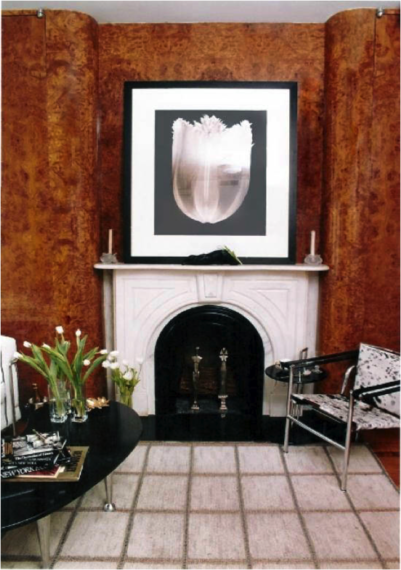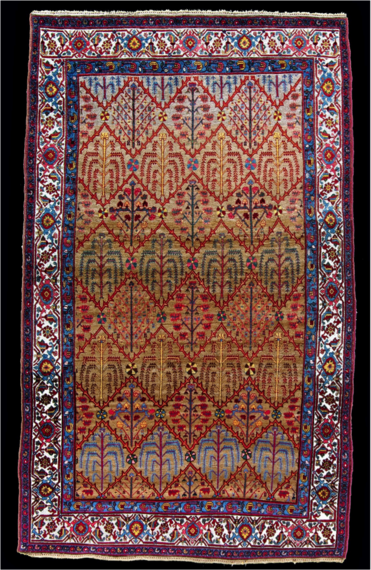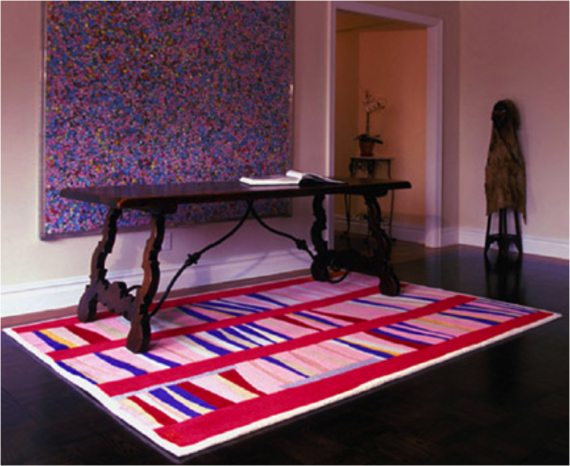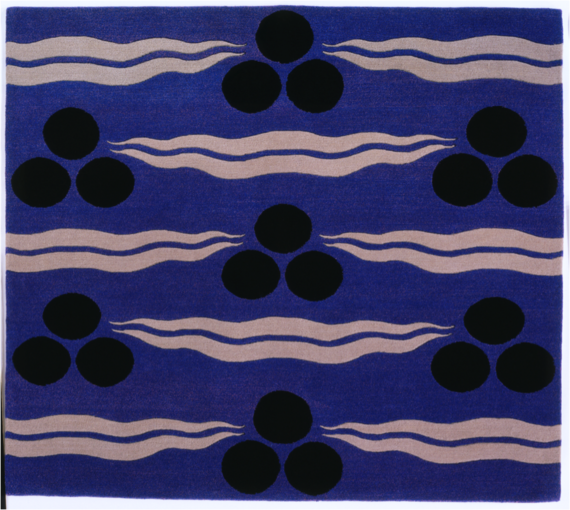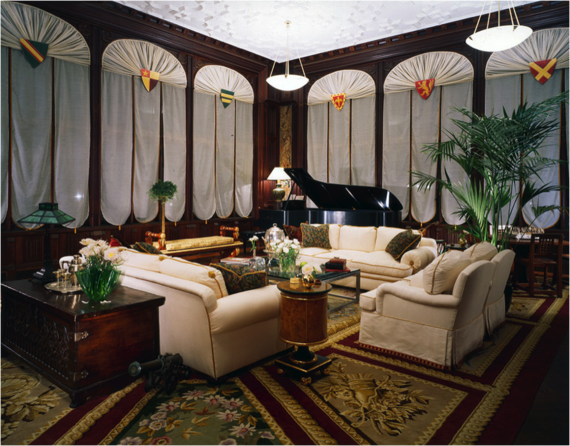As a designer, often the starting point to decorating a room is the floor. This is because it can be the most expensive element for purchase and therefore all other furniture pieces are coordinated around its color pattern and size. In thinking about how floors are embellished, I asked two experts, Douglas Stock of Quadrifoglio and Barbara Barran of the Classic Rug collection, to address some basic questions regarding the importance of rugs and carpets in the home today.
Before we embark on the how's and why's, it is important to define the difference between carpets and rugs. Douglas notes that the division mark is 6" x 9" with anything smaller than is considered a "rug" and anything larger than is considered a "carpet." A long narrow rug is called a "runner."
WHY ARE RUGS IMPORTANT?
As Barbara adroitly notes, "Rugs are wonderful for pulling rooms together. They establish a relationship by pulling all the furniture of a particular space within."
Rugs and carpets draw all the pieces tightly together in a more conversational pattern. They also define a space by drawing a visible line around all the pieces, both uniting them and dividing them from the rest of the room.
Douglas adds that the antique carpets he purveys feature "motifs that interplay both with designs seen in the architecture of the room and other art, furniture and fabrics." Thus, he confirms their more holistic value in connecting the surrounding architecture of a room with its decorative elements.
Both experts express that that a sense of "warmth" is evoked with the addition of a carpet, along with the wonderful feel of walking on a softer, more luxurious surface. In case you are wondering whether an antique carpet would fit aesthetically well with your modern furniture in your high-rise apartment, Douglas assures his clients that "antique carpet comport well with décor from the late 19th and 20th centuries, some with very strong and distinct color palettes."
WOULD YOU PUT A RUG ON TOP OF WALL TO WALL CARPETING OR ANOTHER SINGLE CARPET?
You want wall-to-wall carpeting to provide an overall consistent feel to the room, yet you desire to highlight a certain grouping of pieces with an area rug. The question is: Can you ever use a rug on top of another carpet?
Barbara says this is "a problematic issue. The result is a very tick pile height. However, if you use a larger rug upon which you place a very fine pile, then that is a good trick for getting maximum impact."
"One can absolutely use an Oriental rug on top of other rugs. For people who wish to cover much of the floor with a plain, single color, this option can contribute a splash of color and design that highlights a certain area," says Douglas.
PATTERN OR MONOCHROME?
Choosing between a solid or patterned rug depends on the room's decorating scheme and establishing a balanced overall look.
Douglas says that his viewpoint "is subjective and that he personally finds single color carpets to be boring. I almost invariably disagree with the idea that a colorful, patterned carpet conflicts with or takes away from other art of furnishings in a room. When various types of furnishing are tastefully mixed together they make a whole that is great than the sum of the parts."
Contrary to this perspective is Barbara's take. She says, "If you want to create a serene environment, than choose a monochromatic of tone-on-tone rug. That is why designers choose one-color rugs and broadloom for bedrooms." She also brings up the point that patterned rugs are much more forgiving in terms of staining and visible footprints.
In reality, it is not just the single element of color or pattern, but rather how all the pieces of a room play together which determines what type of carpet is best to use.

(An antique Kazak rug of the Lambalo or Lori-Pambak varieties, Southwest Caucasus, Dated Circa 1913. Quadrifoglio Gallery)
WHAT ABOUT TEXTURE?
Now that you have decided as to pattern or monochromatic, the next question becomes that of texture. Is it soft like silk or hard like sisal? Is it shiny or matte? Is it a cut pile or looped, which tends to be flatter?
Barbara loves to use "New Zealand wool or pashmina paired with silk for a contrast of the matte versus shine to add interest and surface texture. I especially love to use textured rugs in dining rooms because they often have many hard, flat surfaces, so it is a nice contrast to the wood or marble floor."
In addition, Douglas says "flat wovens are popular in warmer climates such as Florida, while heavier carpets such as Sarouks are popular in New England. The depth of pile that a carpet has is consistent with how finely woven the carpet is. Rugs with thin pile not only tend to look clearer but they have a rougher texture than rugs with thick pile."
It certainly makes sense to place softer carpeting in the bedroom and harder tighter loop constructions in the more public areas where you generally don't walk with bare feet.
WHERE SHOULD YOU PUT A RUG IN RELATION TO THE REST OF THE ROOM?
Exactly how to position your carpet on the floor is key in determining a room's success. Do you place all the furniture on or partially off the rug? Should the rug be centered in the room or should it be centered on some other visual, like the fireplace?
For Douglas, these answers depend on whether the floor below is "beautiful wood or marble." He suggests that "it is probably better for the rug to stop short of the wood / marble border rather than cover it. Of course, a dining room will require a single larger carpet that goes under the table and allows about three feet all around for the chairs to be pulled out while remaining on the carpet. For rooms, such as a living room that has a large couch, one typically wants a carpet to either extend close enough to the front end of the couch where your feet rest or to fully extend under the sofa." One should leave at least three to four inches between the end of the rug and the wall.
Barbara wants to see at least six inches of a carpet under the sofa in order to avoid what she calls "the postage stamp effect" where a tiny rug is surrounded by furniture. "Place all of the main seating units on top of the rug and make sure to take into account the view of the seating unit and rug when you enter a room, as sometimes a side view makes a bit more coverage desirable." A carpet has the ability to pull the whole room together by how it "holds" the furniture. If all the furniture is comfortably spaced within the boundaries of the carpet, a more spacious floating feel is achieved.
If some of the furniture is placed off of the carpet -- a statement is being made about the outlying pieces. If a rug is placed with some of the pieces on and some off the carpet, then the rug has a tendency to look lost. In addition, it is always best to try to line up the edges of a carpet with some architectural element of the room -- the end of a wall, the beginning of a doorway, centering on the fireplace, etc.
HOW DO YOU MAINTAIN A CARPET OR RUG?
You bought a carpet you love -- how do you keep it clean?
"Carpets should be professionally cleaned and frequently vacuumed on a regular basis," Douglas insists. He suggests a soak wash of Oriental rugs every three to seven years and, unlike wall-to-wall carpeting should never be cleaned in place." He suggests vacuuming an oriental rug perpendicular to the fringe, preventing pulling on the threads.
Barbara's advice is to "never use a beater brush or cyclonic vacuum on a fine rug; instead use a vacuum that has variable speed, such as a Miele and use the tool attachment on the lowest setting. Remember to never leave the vacuum running in one place on the rug, which can cause great harm to it."
The best advice is always from the professionals selling you your carpets, as they generally know how best to maintain the particular type of rug you are purchasing. Of course, vacuuming once a week is important as well as wiping up spills immediately after happening.
A rug has the ability to unite or divide the cohesion of a room. If placed properly, it will create a balance and proportional flow to the space, which is the end goal to all good design.
For more interior design insight and information, check out Gailgreeninteriors.com
